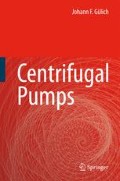Abstract
Operational problems can often be traced back to a non-optimum — or even downright wrong — pump selection. An unsuitable selection may result from insufficient knowledge of pump operation and installation conditions or from not giving them careful consideration and analysis. Common errors in pump selection are:
-
•
The operation range between maximum and minimum flow of the pump has not been defined, its relevance has not been understood or it is different from what had been expected. If the pump is over-sized because too large a “safety margin” was added to the head and/or the flow rate, the pump will run at partload. This entails not only a reduced efficiency but also more vibrations and noise as well as higher wear and the possibility of cavitation damage.
-
•
The maximum possible flow rate in the plant has not been specified or determined correctly. For its definition the minimum head that can result in the plant has to be determined by considering as applicable: (1) the minimum back pressure; (2) the maximum inlet pressure in the process; (3) the minimum discharge water level; (4) the maximum suction level; (5) the minimum pipe resistances. As explained in Chap. 11.1, plants with pumps operating in parallel have to be examined very carefully in this regard.
-
•
For the sake of cost savings an existing pump size is used far outside of the range for which it was designed. This implies heavy trimming of the impeller in order to obtain the specified operation point. Even if the operation point is not too far off the BEP of the trimmed impeller, the pump still runs too far to the left of shockless impeller entry flow QSF, because QSF remains unchanged by the trimming. In that case the pump may permanently operate with recirculation at the impeller inlet, with excessive noise, vibrations, and cavitation damage as a possible consequence, Fig. 4.19.
-
•
The installation conditions of the pump are not sufficiently taken into account. This is particularly relevant in the case of an inappropriate arrangement of the suction pipe or unfavorable approach flow conditions, Chap. 11.7.
-
•
The special conditions required by the process in which the pump is to operate have not been analyzed adequately. This not only applies to the intended normal operation but also to load cycling, start-up and shut-down procedures and upset conditions.
-
•
A pump with insufficient margin between NPSHA and NPSH3 (or NPSHi) is selected leading to problems with vibrations, cavitation noise and/or damage.
-
•
Inappropriate materials are chosen (corrosion, abrasion, cavitation erosion).
-
•
Inappropriate machine elements (bearings, seals, etc.) are used.
Access this chapter
Tax calculation will be finalised at checkout
Purchases are for personal use only
Preview
Unable to display preview. Download preview PDF.
Rights and permissions
Copyright information
© 2008 Springer-Verlag Berlin Heidelberg
About this chapter
Cite this chapter
(2008). Pump selection and quality considerations. In: Centrifugal Pumps. Springer, Berlin, Heidelberg. https://doi.org/10.1007/978-3-540-73695-0_15
Download citation
DOI: https://doi.org/10.1007/978-3-540-73695-0_15
Publisher Name: Springer, Berlin, Heidelberg
Print ISBN: 978-3-540-73694-3
Online ISBN: 978-3-540-73695-0
eBook Packages: EngineeringEngineering (R0)

